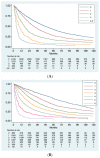Overview of Prognostic Systems for Hepatocellular Carcinoma and ITA.LI.CA External Validation of MESH and CNLC Classifications
- PMID: 33918125
- PMCID: PMC8037197
- DOI: 10.3390/cancers13071673
Overview of Prognostic Systems for Hepatocellular Carcinoma and ITA.LI.CA External Validation of MESH and CNLC Classifications
Abstract
Prognostic assessment in patients with HCC remains an extremely difficult clinical task due to the complexity of this cancer where tumour characteristics interact with degree of liver dysfunction, patient general health status, and a large span of available treatment options. Several prognostic systems have been proposed in the last three decades, both from the Asian and European/North American countries. Prognostic scores, such as the CLIP score and the recent MESH score, have been generated on a solid statistical basis from real life population data, while staging systems, such as the BCLC scheme and the recent CNLC classification, have been created by experts according to recent HCC prognostic evidences from the literature. A third category includes combined prognostic systems that can be used both as prognostic scores and staging systems. A recent example is the ITA.LI.CA prognostic system including either a prognostic score and a simplified staging system. This review focuses first on an overview of the main prognostic systems for HCC classified according to the above three categories, and, second, on a comprehensive description of the methodology required for a correct comparison between different systems in terms of prognostic performance. In this second section the main studies in the literature comparing different prognostic systems are described in detail. Lastly, a formal comparison between the last prognostic systems proposed for each of the above three categories is performed using a large Italian database including 6882 HCC patients in order to concretely apply the comparison rules previously described.
Keywords: discrimination ability; hepatocellular carcinoma; homogeneity; monotonicity of gradients; prognostic performance; prognostic system.
Conflict of interest statement
The authors declare no conflict of interest.
Figures




References
-
- Amin M.B., Greene F.L., Edge S.B., Compton C.C., Gershenwald J.E., Brookland R.K., Meyer L., Gress D.M., Byrd D.R., Winchester D.P. The Eighth Edition AJCC Cancer Staging Manual: Continuing to Build a Bridge from a Population-Based to a More “Personalized” Approach to Cancer Staging. CA Cancer J. Clin. 2017;67:93–99. doi: 10.3322/caac.21388. - DOI - PubMed
-
- Johnson P.J., Berhane S., Kagebayashi C., Satomura S., Teng M., Reeves H.L., O’Beirne J., Fox R., Skowronska A., Palmer D., et al. Assessment of Liver Function in Patients with Hepatocellular Carci-Noma: A New Evidence-Based Approach—The ALBI Grade. J. Clin. Oncol. 2015;33:550–558. doi: 10.1200/JCO.2014.57.9151. - DOI - PMC - PubMed
Publication types
LinkOut - more resources
Full Text Sources
Other Literature Sources

